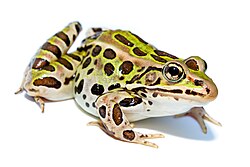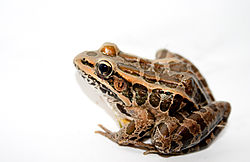Salamanders
Seven species of salamander live in Wisconsin.
| Common name | Scientific name | IUCN status | Wisconsin status | Picture |
|---|---|---|---|---|
| Blue-spotted salamander | Ambystoma laterale | Least concern | Common |  |
| Eastern newt | Notophthalmus viridescens | Least concern | Common |  |
| Red-backed salamander | Plethodon cinereus | Least concern | Common |  |
| Tiger salamander | Ambystoma tigrinum | Least concern | Common |  |
| Four-toed salamander | Hemidactylium scutatum | Least concern | Special concern |  |
| Common mudpuppy | Necturus maculosus | Least concern | Common |  |
| Spotted salamander | Ambystoma maculatum | Least concern | Common |  |











